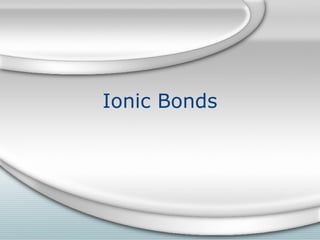Ionic bonds
•Als PPT, PDF herunterladen•
7 gefällt mir•15,393 views
Ionic bonds form between metal and nonmetal atoms when electrons are transferred. Positively charged metal ions are called cations, and negatively charged nonmetal ions are called anions. Ionic bonds occur when cations and anions are attracted to each other due to their opposite charges, balancing out the overall charge. Ionic compounds write their chemical formulas to represent this charge balance between the ions.
Melden
Teilen
Melden
Teilen

Empfohlen
Empfohlen
Weitere ähnliche Inhalte
Was ist angesagt?
Was ist angesagt? (20)
Properties and Formation of Ionic Compounds Powerpoint

Properties and Formation of Ionic Compounds Powerpoint
Valence shell electron pair repulsion theory (VSEPR THEORY)

Valence shell electron pair repulsion theory (VSEPR THEORY)
Ähnlich wie Ionic bonds
Ähnlich wie Ionic bonds (20)
Comparison-of-Properties-of-Ionic-and-Covalent-Compounds.ppt

Comparison-of-Properties-of-Ionic-and-Covalent-Compounds.ppt
Mehr von MrsKendall
Mehr von MrsKendall (20)
Ionic bonds
- 1. Ionic Bonds
- 2. Ionic Bonds • An ion is an atom with a positive or negative charge. • Ions form by atoms gaining or losing an electron. – They become positive when they lose one or more electrons – They become negative when they gain one or more electrons.
- 3. Ionic Bonds • Ionic bonds occur between metals and non metals. – Metals form positive ions – Nonmetals form negative ions.
- 4. Ionic Bonds • Positive ions are called cations • Negative ions are called anions • Cations have lost electrons and anions have gained electrons.
- 5. Ionic Bonds • Because opposites attract, when ions form, they bond to one another due to magnetic attraction. – EX: Na (sodium) needs to lose one electron to become stable, Cl (chlorine) needs to gain one electron to become stable. Na becomes positive, Cl becomes negative and they bond due to their opposite charges.
- 6. Ionic Bonds • Writing the formula: – When ionic compounds form, they balance out the charges of the ions. The formula must represent this balance.
- 7. Ionic Bonds • Writing the formula: – 2 Chloride ions (-1) will balance out the charge of a Magnesium ion (+2). – We write this formula out: MgCl2 – The subscript 2 tells us that we have 2 Chlorine atoms. If no subscript is written that means there is only one atom.
- 8. Ionic Bonds • How many atoms of each element do I have in the following formulas? – Sodium Chloride: NaCl – Calcium Carbonate: CaCO3 – Ammonium Nitrate: NH4NO3
- 9. Ionic Bonds • Properties of ionic Compounds – Hard and brittle solids with very high melting points. – When dissolved in water, they conduct electrical currents.